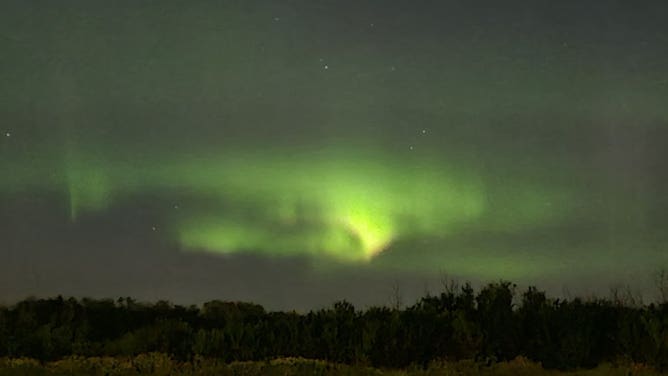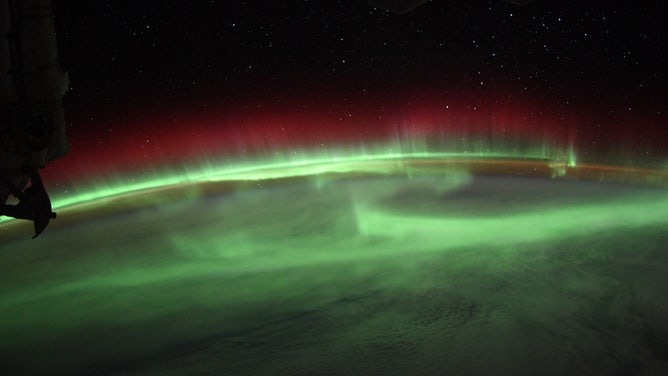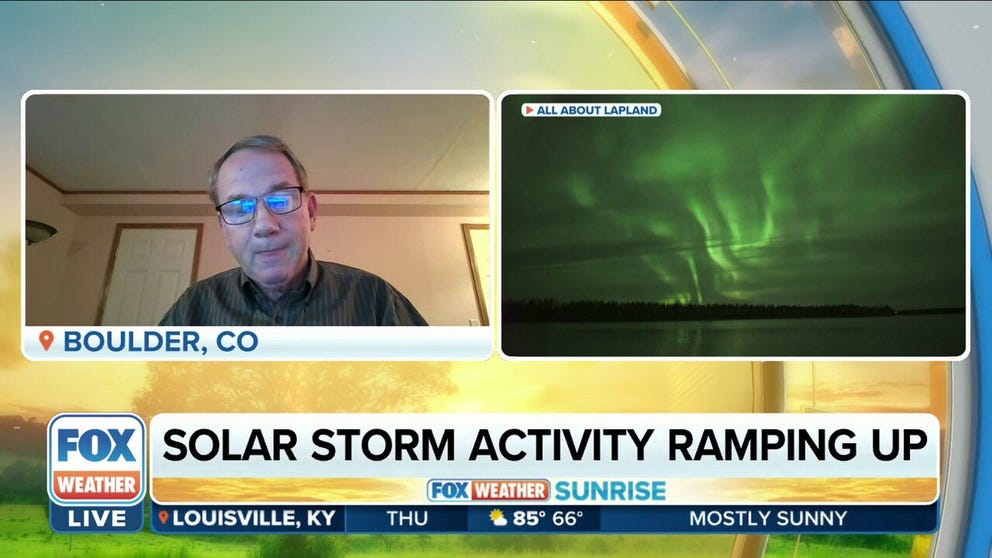Astronaut, satellites capture beauty of aurora borealis from space
A cannibal coronal mass ejection is producing dazzling aurora lights this week. NOAA space weather experts say solar activity is increasing, which could mean auroras seen as far south as Florida and Texas in the coming months.
Looking up at the aurora lights is breathtaking, but what about a view from above? The astronauts living on the International Space Station are enjoying watching the increasing aurora borealis activity from 200 miles above Earth.
A geomagnetic storm created by eruptions from the sun is producing colorful northern lights and is expected to dazzle even in the northern tier of the U.S. this week.
On Wednesday, NASA Astronaut Bob Hines shared photos of the northern lights taken from the space station.
"Absolutely SPECTACULAR aurora today!!!" he tweeted. "Thankful for the recent solar activity resulting in these wonderful sights!"
Because the ISS orbits Earth, experiencing 16 sunsets and sunrises daily, astronauts have the perfect opportunity to witness the light show.
Hines and his fellow astronauts weren't the only ones with a view from above of the aurora borealis.
The National Oceanic and Atmospheric Administration's polar-orbiting satellite NOAA-20 recorded the auroras sweeping across northern latitudes from space.
Down on Earth, people north of the U.S. have already been experiencing the green glow of auroras from the geomagnetic storm.

The aurora lights west of Bashaw in Alberta, Canada on Aug. 17, 2022. (Image credit: @dartanner/Twitter
The image above and below from Alberta, Canada were captured Wednesday night with some of the brightest aurora lights forecast on Thursday into Friday.

Aurora lights seen over Edmonton in Alberta, Canada on Aug. 18, 2022. (Image: @Indygirlmomma / SCI + TECH /TMX)
Solar cycle ramping up
The science behind why the auroras are so colorful this week is equally interesting.
Geomagnetic storm to produce Northern Lights this week
NOAA Space Weather Prediction Center experts have been monitoring the sun and forecast a G3 geomagnetic storm. William Murtagh with NOAA Federal, goes into more detail about this geomagnetic storm.
Beginning on Aug. 14, a series of eruptions started traveling at a rate of around 1 million mph towards Earth, prompting NOAA's Space Weather Prediction Center (SWPC) in Boulder, Colorado, to issue a level 3 Geomagnetic Storm Warning.
GEOMAGNETIC STORM: WHEN THE NORTHERN LIGHTS WILL BE VISIBLE IN THE US
William Murtagh, with the SWPC, explains that when these coronal mass ejections blast a billion tons of plasma into Earth's atmosphere, it creates a disturbance or a geomagnetic storm.
Since there were two eruptions and the second more significant episode overtook the first in space, the event is known as a cannibal coronal mass ejection.
Below is a glamour shot of the Aug. 15 and 16 eruptions by NOAA's GOES East satellite using the Solar Ultraviolet Imager.
Most people do not need to worry about impacts from geomagnetic storms. However, NOAA warns power grid fluctuations can occur, satellite irregularities are possible, and radio and GPS signals may temporarily fail or become weak.
"Once we get up to the 4 and 5 level (storm) it can cause considerable problems to a lot of our technology that we rely on for everything we do today," Murtagh said. "It affects satellites, communications systems and particularly the electric power grid."
THESE ARE THE 5 CATEGORIES THAT MEASURE GEOMAGNETIC STORMS
NOAA says this level 3 geomagnetic storm could produce auroras in the northern tier states and may be seen as far south as Pennsylvania, Iowa and northern Oregon.
Geomagnetic storms can also impact astronauts living on the International Space Station, and eventually on the moon and Mars.
Earth's atmosphere offers protection from solar radiation for people down on the ground. In low-Earth orbit, astronauts are more vulnerable to radiation. This is one reason why space weather is a factor that mission control considers before NASA astronauts step outside the ISS for a spacewalk.
According to the European Space Agency, in one week astronauts are exposed to the equivalent of one year's exposure down on Earth. NASA and ESA limit astronaut radiation exposure over their spaceflight careers.
In July, another geomagnetic storm created a dazzling light show over North America, even in Seattle.
Murtagh said as the current solar cycle ramps up, "really big" level 4 and 5 storms could produce aurora lights as far south as Texas and Florida.
"We do expect that in the coming months and years," Murtagh said.
A typical solar cycle lasts about 11 years as the sun's magnetic fields completely flip, impacting activity on the star's surface.




